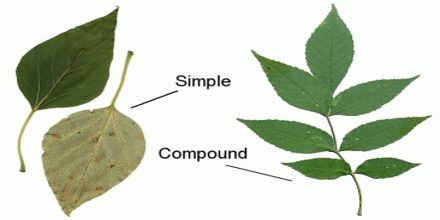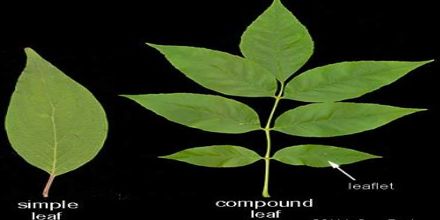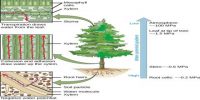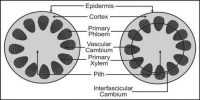The leaf is a green, flat, thin, expanded lateral appendage of the stem. This part is borne at a node and bears a bud in its axil. The green color of the leaf is due to the presence of the photosynthetic pigment – chlorophyll.
Leaves are the power-stations of any plant or tree. They are a source of power for many plants and trees because that’s where all of the food material converts its energy for the plant. Take a mango leaf and a tamarind leaf to observe them. You will see that the lamina in the mango leaf is not lobed while the lamina in the tamarind has more than one leaflets. On the basis of the characteristic of leaf blades, leaves can be divided into two groups-
(i) Simple leaf – It has a single blade on its stalk and the stalk is attached to the plant body.
(ii) Compound leaf – It is a leaf stalk that has more than one leaf blade on it, and the multiple leaf blades are called leaflets.
Simple leaf: A Simple leaf contains the only leaflet. Leaves of mango and Jack fruit trees are simple leaves. The edge of a simple leaf is either totally unbroken or moderately incised. A simple leaf has a single blade. The leaf blade includes the entire leaf formation apart from the stem, so the blade is basically the leafy part of the leaf. A simple leaf may have incisions but these incisions are not deep enough to divide the blade into leaflets (one of the subdivisions of a compound leaf). Simple leaves may have rounded, jagged, or lobed edges. Common examples include those found on oak and maple trees and many fruit plants, like grapes and strawberries.

Compound leaf: The blades of compound leaves are divided into distinct parts called leaflets. The multitude of leaflets makes one single leaf that’s attached to a single stalk. A leaflet is a smaller leaf blade that extends from the vein. Observe the leaves of the rose, neem, tamarind, and moringa (Sajna) plants. You will see that each of these leaves has many small laminae. These are leaflets. The lamina of a compound leaf is completely divided and the divided pans make the leaflets that are separated from one another. The branch like structure bearing the leaflets is called the rachis or axis. There are different types of pinnate compound leaves. According to the arrangement of the leaflets, compound leaves are of two kinds- Pinnate compound leaf and Palmate compound leaf.
Some other types of Leaves
You have probably come across a variety of plants with dissimilar shapes and sizes of leaves. They are categorized as follows:
- Acicular type (needle-shaped)
- Linear Type (long and relatively broader)
- Lanceolate Type (lance-shaped)
- Oblong Type (rectangular in their shape)
- Reniform type (shape of kidneys)
- Cordate type (heart-shaped)
- Saggitate type (arrow-heads)
- Elliptical Type (shapes of ellipses)
- Ovate Type: (oval or egg-shaped)
- Lyrate Type (shape of a lyre)
- Spatulate Type (resembling spatulas or spoons)
- Centric Type (cylindrical and hollow)
- Cuneate Type (wedge-shaped)
Functions of Leaves
The main function of a leaf is to go through photosynthesis. A leaf cell contains chloroplast that’s exposed to light to instigate the procedure of photosynthesis.
Photosynthesis in plants usually involves the green pigment chlorophyll and generates oxygen as a by-product. Leaves can also absorb water vapor from the air, store food and water, give shield and carry out many other functions to help the tree survive.













